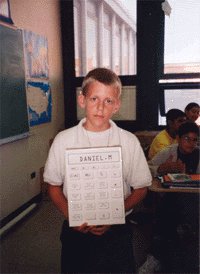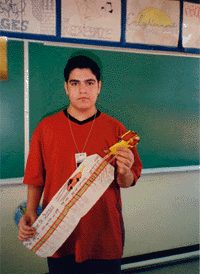Making the Right Connections in High School: Developing Teaching Teams to Integrate the Curriculum
“If you want to get ahead, you need the right connections.” No doubt, many of us have found this advice helpful in our lives, but I believe this old adage goes far beyond the implication that knowing the right people will open doors for us. Intellectually, our brains thrive on connections too, searching for patterns and interconnections as the way to make meaning. James Burke, a well-known writer and host of the PBS documentary series Connections, proposes that “learning to identify the pattern of connections between ideas, people and events is the first step towards understanding the context and relevance of information” (Burke, 1999). Unfortunately, traditional education, especially at the high school level, which I teach, doesn’t do enough to encourage either personal or intellectual connections.

I came to this conclusion when I began teaching after 15 years of working as a graphic designer and marketing manager. I was prepared to bring my experiences from business into the classroom. I wanted to help my students see, as I had seen, that everything they were learning in school would build the foundation for their future quests and questions. I was unprepared, however, for how disconnected I felt from other teachers. Isolated in our respective classrooms, we taught our subjects disconnected from the ways we used them in our non-teaching lives.
This was a stark contrast to my business experience, where my personal connections had included daily meetings with other professionals. We had collaborated, argued, and compromised to get the job done. My teaching experience was nothing like that. Except for monthly department meetings or a few quick words exchanged while waiting at the copy machine, teachers have very little opportunity to share with each other what they do in their classrooms.
The experience of my students also was at odds with what I knew would likely be their experience in the working world. In business, I had drawn on all my educational resources—knowledge and skills in science, mathematics, history, reading, writing, and research—to create budgets, conduct meetings, write letters, or plan trips. None of these tasks had fallen neatly into 40- or 50-minute periods devoted to one skill or subject area like one finds in the traditional high school.
This is why James Moffett argued vehemently that curricular integration should be the goal of education—for the simple reason that “life is not divided into subjects” (Moffett, 1992). The jigsaw approach to learning only works when the entire puzzle is finally put together. When students are repetitively taught to focus on math, then English, then history, and are not required to link them in some way, they lose the ability to make the critical connections that work and life will demand of them. Further, they lose the enthusiasm that comes from playing with the puzzle pieces and the excitement of discovering where they fit.

But integrating the traditional high school curriculum isn’t easy. Even after the wall of resistance from school board members, administrators, union representatives, parents and fellow teachers has been broken down, integration takes time and commitment. Many schools have found that a first step toward building an integrated curriculum is the process of creating teams of teachers from diverse subject areas. For team teaching to work, however, teachers need administrative support and time for pedagogical discussions that will lead to a greater understanding about what will be taught and how it will be integrated. This understanding in turn leads teachers to a deeper recognition of how they work and how they relate to students, colleagues, and parents.
Morton East High School in Cicero, Illinois, where I teach, has been experimenting with several models of team teaching for over a decade, beginning in 1992 with American Studies, a class that combined American history and American literature. The students who took this class scored higher on our local writing assessment than the students who took history and literature separately. This first step was encouraging, especially since the school faces several challenges. Over 80 percent of the 3,500 students are Hispanic, so English is not their first language. Over 50 percent come from families at or below a poverty level income, and until last year, our graduation rate was only 60 percent. Clearly, some grassroots changes were necessary to deal with these problems if our students were to get a quality education.
In response to these conditions, along with five other teachers, I helped design a pilot program for reorganizing freshman teachers in English, math, social studies, science and selected electives into teams that would share 100 students each. Teams of teachers were all given a common preparation period so that they could meet together. This allowed them to work as a team, get to know the students better, and eventually integrate their subject areas. The plan became a reality in 1995 and now includes 11 teams, or “houses” as we call them, for all our freshman students. In 2000, Morton received federal funding from the Smaller Learning Communities Grant Program to support this expanded implementation. Since the teams were created, freshmen students have had a higher rate of daily attendance than the rest of the school (93 percent); they have passed a greater percentage of their classes; and last year, the school had the largest graduating class in over 20 years.

Each of the 11 houses comprising Morton’s freshman class develops its own distinct personality based on both the teachers and students involved. Some teachers have been together for three years; others for less time. Usually, the English and social studies teachers, a well-established team, work together in the same room with 50 students during a double 50-minute period to teach world studies. Their curriculum is tightly integrated so that the lines between English and history are often irrelevant to the broader concepts and ideas the students are learning. Well-established houses such as these often plan special events and thematic units that incorporate all the subject areas. One has developed its own student governing system. Newer houses, even though they continue to teach their class curriculums separately, may still coordinate classroom management policies, plan field trips, or conduct parent meetings together.
For four years, I was part of a four-person team that included English, biology, mathematics, and fine arts teachers. Sharing the same 100 students, we developed several integrated thematic units and activities. Students researched famous artists and then portrayed them in a talk-show setting. They studied human genetics in biology (supplemented with lessons on probability in math), created personal family trees in art, and held a medical symposium where they took on the roles of geneticist, family physician, or therapist to inform parents about a variety of genetic diseases. We also combined the study of animals with the creation of fables. Students then designed and constructed their own animal masks so they could act out the fables in reader’s theater.
Last year, I received the James Moffett Memorial Award to work on a team-teaching manual. It is designed to provide support for the different teaching teams we have at our school by including information about the personal dynamics of team teaching as well as ideas for integrating subject areas. In the third of ten chapters, I outline the challenges of building a strong team. “Just as the structure of any house depends on a firm foundation that will support it through time and weather, each team of teachers needs to build a firm foundation for working together as a team. There will undoubtedly be conflicts and disagreements, but understanding each other’s diverse personalities, skills, experiences, and philosophies is crucial to building a strong foundation for working together as a team.”
My own experience and those of other teachers who have taken on the challenge of team teaching confirm that it produces powerful results. Team teaching connects teachers to each other, offering a support network with their fellow team members, parents, and other school staff. Since many businesses involve some kind of teamwork, modeling this structure for our students connects them to the world they will encounter when they leave school. But the paramount reason for creating strong teacher teams is the stimulating curriculum they will create for the students. Our students will learn that making the right connections isn’t just about shaking hands with the right people. It’s about preparing their minds to explore a world that has infinite connections to their own lives.

